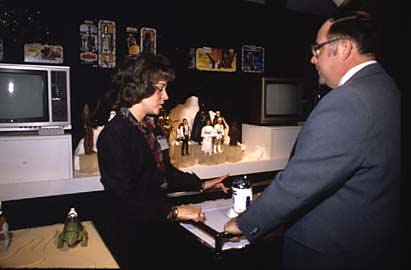
The American International Toy Fair (Toy Fair)
The American International Toy Fair--usually referred to simply as Toy Fair (and just "Toy
Fair"-- it's not called "the Toy Fair")--is the name given to the key business event for the entire toy
industry that has taken place since 1903. It takes place over the course of a full week early in the year (nowadays it's in February) in New York City, and most major toy companies send a delegation of employees and a ton of product to the event. The biggest of these companies (e.g. Hasbro, Mattel) have their own buildings; the smaller ones (e.g. Trendmasters, McFarlane) make do with large showrooms, which they rent out and decorate lavishly. What takes place at Toy Fair is, to put it simply, promotion, buying and selling, with a hefty dollop of shmoosing thrown in for good measure. Retailers send representatives (called "buyers"), who book appointments with manufacturers. The appointment typically consists of a tour around the manufacturer's show room, during which the buyer is shown and demonstrated not only upcoming toy product, but the promotional campaigns that will be used to sell it as well. If the buyer likes what he sees, he'll place an order for Walmart, Target, Joe's Sci-Fi Shop, or whatever company he works for. This is no small decision; in some cases, retail chains will commit to buying a product for the Christmas season in Feburary, some 10 months before Christmas even arrives! Of course, where toy lines attached to summer films are concerned, this can be problematic, as companies must decide whether or not they want to invest thousands of dollars in something that might ultimately flop. But such are the risks of the toy industry.
Since something as complicated as, say, an action figure line takes close to a full year to go from concept to production, manufacturers will often send prototype product to Toy Fair for use as selling aids. Very often, the further development of these prototypes depends fully on the attention they garner at Toy Fair. If no major buyer shows interest in purchasing the product, development will be halted. This is very likely what happened in the case of some of Kenner's unproduced product lines, including the Empire Strikes Back 12" dolls and the second series of Droids and Ewoks figures. Whether these items were shown at Toy Fair or not, they were cancelled due to retailer disinterest. And it makes no sense for a toy company like Kenner to invest money in producing something that they can't make money selling.
In addition to being a treasure-trove of prototypes, Toy Fair is always chock full of wonderful displays. Everything from hand-made signage to large, complicated dioramas is installed within the company show rooms. Of course, this type of thing is usually thrown out at the end of the week-long event, but that doesn't mean that none of it has found its way into the hands of collectors.
Any way you cut it, Toy Fair represents the focus of a toy company's year. Other, smaller "toy fairs" are held as well, in other parts of the country, but the Toy Fair in New York is the major event. During the vintage Star Wars years, a mid-size company like Kenner would work night and day in order to get prototypes ready in time for Toy Fair, and everything would be driven out in a truck several nights prior to the event for quick installation in the company's showroom. Employees in Cincinnati would come to New York, meet up with regional salesmen, and everyone would work at installing the displays. Every year much time and money was spent in developing large, glossy catalogs; special items such as buttons were even distributed to help promote toy lines, including Star Wars.
See Also:
Kenner "May the Force Be With You" Toy Fair Button
Kenner Retailer Catalogs
Darth Vader Coin Toy Fair Display
ROTJ Hand-Made Toy Fair Sign
Micro Collection "Toy Fair Breakfast" Award
Rocket Firing Boba Fett - Carded Toy Fair Mock-Up
Description: Ron Salvatore